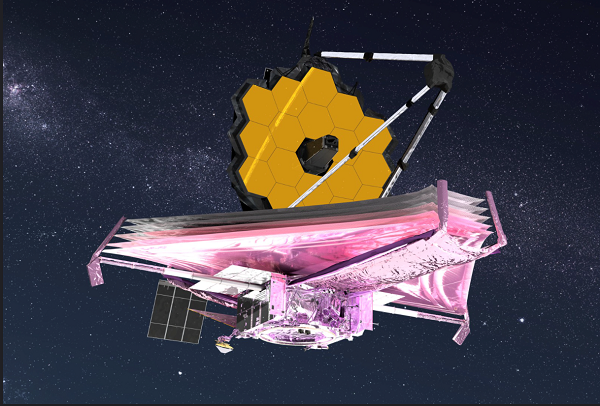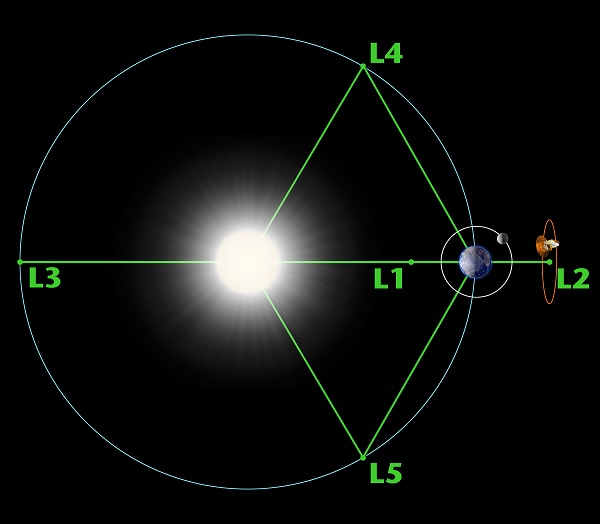Astronomers worldwide got a special Christmas gift this past year with the liftoff of the James Webb Space Telescope. It has just arrived (as of January 24) at its destination. By summer, it will begin 10 years (or more) of probing the deepest regions of the universe.

The James Webb Space Telescope is a collaboration between NASA, the European Space Agency (ESA), and the Canadian Space Agency (CSA). It blasted off from the Guiana Space Center near Kourou, French Guiana, on Christmas morning. Although the James Webb will succeed Hubble as NASA’s flagship mission, it is quite different from its predecessor.
First of all, it is much larger. Hubble’s main mirror is 2.4 m (7.9 ft) across. James Webb, on the other hand, combines 18 hexagonal mirrors to make one large mirror 6.5 m (21 ft) across. This makes the light gathering area over 5.5 times that of Hubble.
Also, Hubble observed mostly the same light we see with our eyes. James Webb however, is designed to look at infrared light, with wavelengths too long for our eyes to see. Looking at these wavelengths, James Webb will see much farther than Hubble. Because the whole universe is expanding, distant galaxies are all moving away from ours. As a result, their light is redshifted. The most distant galaxies have much of their light shifted past red into the infrared range. Thus, they will look brighter to James Webb than to Hubble. Since 1995, we have found almost 5,000 exoplanets (planets around other stars). Scientist have been studying these exoplanets to see if there are any similar to Earth, or even if any might harbor life of some kind. This has been a challenge, as planets are too cool to shine visibly. However, they do give off infrared light, so James Webb can image them directly while Hubble cannot. Also, with James Webb we hope to study the formation of galaxies and stars. This involves looking for dust, out of which new stars form. In visible light, dust is dark and visible only if it is in the way of something bright. However, in infrared light dust actually glows. Thus, James Webb will see more dust clouds than Hubble.
Detecting infrared light presents a challenge, however. Objects too cool to glow visibly can be sources of infrared light. This includes our own bodies, the dust we are trying to find, and….the telescope itself! Yes, the mirrors and detectors on James Webb itself can be much brighter infrared sources than the very distant objects we are trying to study. To prevent this, we need the telescope to be at a temperature less than 40 K (-387.67 oF). Fortunately, space is cold enough. A telescope open to space will cool to an acceptable temperature and stay that cold, so long as the Sun never shines on it. Although James Webb will be almost four times farther from Earth than the Moon is, it will remain much closer to Earth than to any other planet. If we define Sun-Earth distance as 1 astronomical unit (AU), the Sun-James Webb distance is about 1.1 AU. Sunlight shining on James Webb is about as hot as it is on the Earth, and can raise the telescope’s temperature to over 100 oF, making the science we want to do impossible. Therefore, we must open James Webb to space, and make sure it gets no sunlight.

To accomplish this, we have placed James Webb at Lagrange point 2 (L2). In 1772, Joseph Louis Lagrange published an “Essay on the third body problem”, in which he described how a third body might move in a system where one small body (such as Earth) orbits a much more massive one (such as the Sun). In this work he described five points where a third object would remain at the same position relative to the other two, if the third object is much less massive than either of them. (Leonhard Euler had already identified points 1-3 shortly before Lagrange’s publication). For the Sun-Earth orbit, L2 is directly in line with Earth and Sun, about 1.5 million km (930,000 miles) ‘behind’ the Earth. Placing James Webb here puts the Sun, Earth, and Moon on the same side of the telescope at all times. We have deployed a five layered, tennis court sized sunshield that will perpetually block not only direct sunlight, but also any reflected sunlight from the Earth or Moon. This sunshield is designed to absorb and dissipate heat from sunlight, transmitting virtually none of it to the James Webb science equipment. The telescope can’t be right at the L2 point as this point is unstable (an object that is off by a small amount would tend to fall away from the L2 point). Instead, it will be in a halo orbit around L2 almost as large as the Moon’s orbit around Earth, completing one orbit about every 180 days. In this orbit, James Webb will always go around Earth’s shadow and not through it. This way, the sunshield is always exposed to the Sun, allowing for solar panels there to serve as a power source. It also avoids a change in temperature for the spacecraft that might affect performance.
With the telescope now in position, the next step is to align the mirrors. Although all 18 mirrors were raised into position before the arrival at L2, they now must be adjusted by a few microns and nanometers so that they function as one large mirror. This process should take about three months. Then scientists will begin a process of calibrating the equipment once it is cold enough to start up. This involves among other things, pointing James Webb at a bright star to test the response of the equipment. By summer, we should be getting our first images from James Webb.
The launch was so smooth that the telescope used much less fuel than we feared to break Earth’s gravity. Thus, it has more fuel to execute its halo orbit around L2, and the mission could go much longer than the 10 years we hoped for. Astronomers have already scheduled 300 observing projects to begin this summer. A new era of astronomy has begun.
Take a look at Sky Happenings for the month of January right here.





